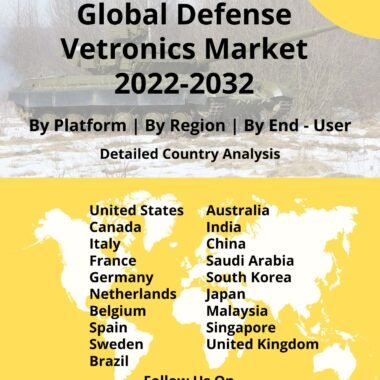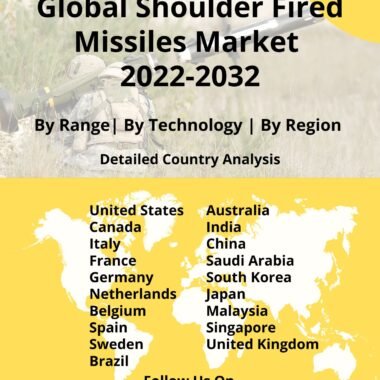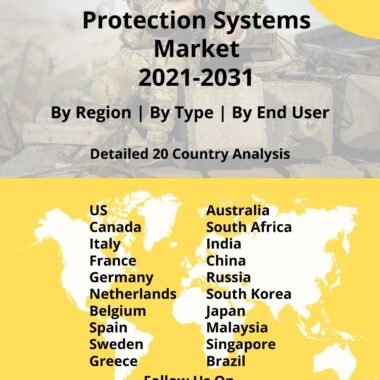Description
Global Defense Vetronics Market
Frequently Asked Questions of Vetronics Market
Defense vetronics market solutions are platform-specific, lowering size, weight, and power consumption (SWaP). By merging many LRUs and functionalities, vetronics solutions communicate, control, and coordinate duties like data control/distribution, computer resources, crew controls/displays, and power generation/management. Delivering a strong mil-spec qualified design using commercial off-the-shelf standard-based technology addressing unique platform needs in a cost-effective customized solution that can be implemented fast is a pressing need. Mission systems are the ‘payload’ of ground military vehicles, supplementing the vehicles’ primary capabilities, which include mobility and protection. Weapons; command, control, communications, computers, and intelligence (C4I); acoustic shooter locating; 360° camera vision (visible or infrared); radar; laser warning; and other subsystems enable the vehicle to undertake a range of difficult missions.
The advancement of information technology applicable to land vehicle mission systems follows a rapid innovation cycle. It has the capability of providing superior situational awareness as well as speedier, more efficient, and precise military effects. However, its complexity may prevent such potential from being realized, and the engagement of numerous mission system suppliers must be controlled by the standardization of key best-practice architectural techniques By providing each member of the crew with a common terminal set for their unique purpose, they can operate all of their equipment from a single place and, with the use of so-called ‘groupware,’ they can communicate not just verbally, but also digitally.
Currently, numerous independent and individual sub-systems are employed for a military vehicle mission system, which does not share information and is difficult to run. “Especially with the increased demand on higher performing, more adaptable, and increasingly IT-based mission systems, an Open Architecture approach is important to make such systems deployable, to manage complexity, to make them economical, and to promote innovation. For today’s highly mobile and dynamic military operations, fast and reliable information networks are critical. Vehicle-mounted information technology is transforming the battlefield, giving capabilities critical to maintaining a tactical advantage.
Major factors driving Defense Vetronics Market Growth
The movement toward open reference architecture systems is fueled by a rising demand for military land vehicles, particularly armored fighting vehicles (AFVs), to be outfitted with networked information technology that provides optimal situational awareness and combat capabilities. Using integrated mission systems to ensure full data-exchange interoperability across all types of land vehicles involved in an operation has become critical, both operationally and economically (cost savings). The operational efficiency and effectiveness in a networked environment can be dramatically increased with no significant cost increase thanks to open-source technology standards. This is one of the major market trends that will drive the growth of the market.
Trends influencing the Defense-Vetronic Market Size
Modern digital communications systems are susceptible to influence from neighboring electrical devices. Vetronic equipment is well protected and will not interfere with or compromise the function of other systems placed in the car. It is also not susceptible to external influence. Military-standard connectors, climatically sealed housing, easy maintenance, minimal parts, and low power consumption are the key design advantages. The need for ruggedized solutions is to gain traction. These are some of the technological market trends that are influencing the growth of the market. 3D printing is also one of the other key technological market trends that will continue to influence market growth.
Defense-Vetronic Market Forecast & Dynamics
Increasing defense spending will enable the procurement of newer land vehicles. Nations are also investing in developing the next generation of C4ISR solutions for land vehicles for the smooth flow of information across platforms. The increase in defense spending will also encourage upgrading existing land vehicles with newer technologies and equipment. Procurement will also be driven by prevailing geo-political conditions in Europe and the Asia Pacific. The defense vetronics market forecast includes a comprehensive Defense vetronics market analysis and Defense vetronics market size. The market analysis includes regional market size, drivers, restraints, and opportunities. The regional analysis also includes country-wise market size.
Defense Vetronics Market Analysis for Recent Developments
JLTV combat vehicles with VICTORY-based vetronics and open-systems standard electronics are being fielded by Oshkosh. The Oshkosh JLTV is a multi-role light utility and combat vehicle with open-systems standard electronics. The battle vehicle is projected to provide protection comparable to that of existing Mine Resistant Ambush Protected (MRAP) class designs, but substantially better than the latest armored HMMWV combat vehicles. The JLTV is equipped with a vetronics architecture that meets the Army’s VICTORY electronics standard. VICTORY is an acronym that stands for Vehicular Integration for C4ISR/EW Interoperability. Command, control, communications, computers, intelligence, surveillance, and reconnaissance/electronic warfare are abbreviated as C4ISR/EW. The modular, scalable, open-architecture vetronics of the JLTV are designed to handle rapidly growing C4ISR suites.
Today’s vehicle electronics systems are increasingly focused on C4ISR [command, control, communications, computers, intelligence, surveillance, and reconnaissance], interoperability with other battlefield assets, and the capacity to be unmanned if necessary. They are also more likely to be developed on open architectures, as the United States Department of Defense (DoD) pushes for a modular open systems approach (MOSA) in updates and new designs. For military ground platforms, the term “vetronics” refers to how vehicle electronics (vetronics) enable enhanced command, control, communications, computers, intelligence, surveillance, and reconnaissance (C4ISR); position, navigation, and timing (PNT); electronic warfare (EW) capability; optional unmanned capability; and connection to a larger defense network.
The global landscape of Defense Vetronics (Vehicle Electronics) has evolved significantly, playing a crucial role in enhancing the capabilities and connectivity of military vehicles. Defense Vetronics encompasses the electronic systems integrated into military vehicles, contributing to communication, navigation, surveillance, and overall vehicle management. Advancements in Defense Vetronics include the integration of advanced sensors, communication systems, and electronic warfare capabilities. These systems enhance situational awareness, communication between vehicles, and the ability to respond to threats in real-time.
The development of modular and scalable Vetronics architectures allows for easier upgrades and integration of new technologies into existing military vehicle fleets. This adaptability ensures that military forces can stay ahead of evolving threats and Defense vetronics market trends. Global collaboration and standardization efforts support interoperability among different military platforms, facilitating joint operations and coalition activities. The integration of artificial intelligence and machine learning into Vetronics systems further enhances the decision-making capabilities of military vehicles. The ongoing evolution of Defense Vetronics in 2023 signifies a commitment to leveraging cutting-edge technologies for improved military vehicle performance, connectivity, and the overall effectiveness of defense operations.







